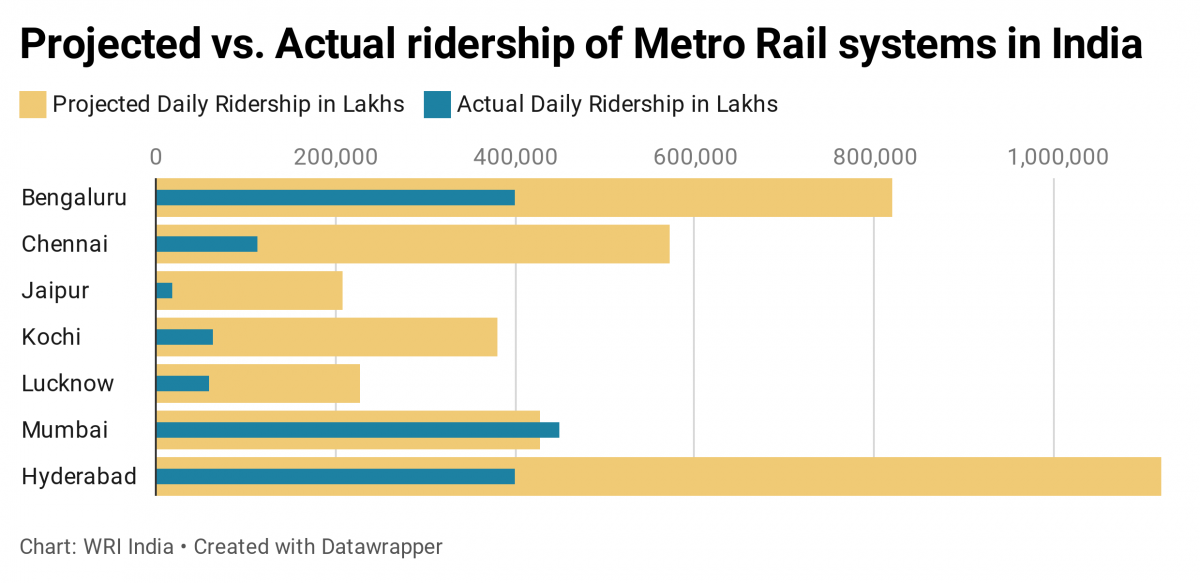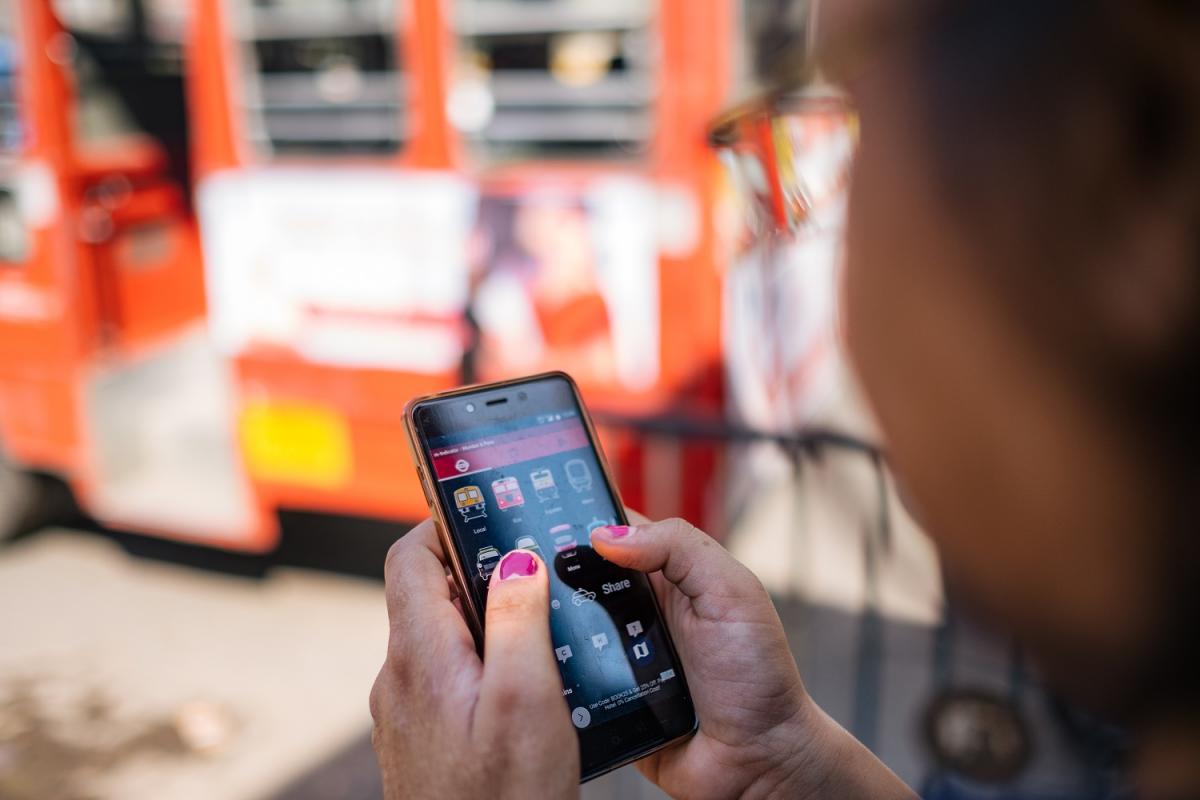Feeding into metro rail: New mobility services for last mile commute
by , , e -
Responding to rapid urbanization and growing congestion, several Indian cities have invested in metro rail networks to provide sustainable and affordable mass transit that can cater to large volumes of people. However, a majority of metro systems have not been able to reach their projected ridership. This shortfall has been attributed to a lack of comprehensive first-and last-mile solutions to connect homes, offices, and other activity centers with metro stations. In 2016, 70% of potential Bangalore Metro users cited poor first- and last-mile connectivity as a reason for not using it, according to a WRI survey.
Currently, metro commuters primarily walk to and from stations, or use shared rickshaws, private two-wheelers and buses. Over the last few years, new mobility enterprises have also started offering last-mile services to improve access to and from metro stations.

New mobility grows as last-mile alternative
New mobility enterprises utilize innovations in technology and business models to provide on-demand and shared mobility services, which are increasingly popular as transport options in cities. In collaboration with metro agencies, new mobility operators now provide a range of last-mile solutions for metro commuters, including e-scooters, motorized two-wheelers, auto rickshaws, and shuttle buses. Table 1 (below) lists various mobility enterprises offering last-mile services for metro rail in some major cities.

The quality and efficiency of these last-mile services depend significantly on the arrangements between mobility enterprises and metro rail operators—which vary across cities and between companies. Differences in roles and responsibilities, conditions of operation, and the allocated risk associated with different contracts can also impact service quality for passengers and financial sustainability of involved parties. This can be explored by looking at metro systems in Kochi, Bengaluru and Delhi, and analyzing last-mile service arrangements between the metro rail operators and various private mobility enterprises.
Differences in service agreements lead to varying results
The terms of engagement between metro rail operators and private feeder service providers are commonly defined through a Memorandum of Understanding (MoU) or a service contract. MoUs are non-binding agreements between cooperating parties, whereas service contracts are enforceable and are commonly signed following a competitive bidding process to select feeder service providers.
How financial risk is allocated varies across different types of agreements as well. MOUs are seen as low risk. However, for service contracts, risk allocation is a significant factor in enabling private sector participation, as enterprises will only participate or continue to participate in partnerships with an acceptable level of risk.
Kochi:
In Kochi, an MoU was signed between the metro rail operator, private enterprise, and the local auto rickshaw association. A manufacturer of battery-operated vehicles procured e-autos for the drivers, who paid a fixed daily fee to rent the EVs while keeping the rest of their earnings.
Kochi Metro, in turn, provided spaces to park, charge, and hail e-vehicles at metro stations. For uncharted, exploratory partnerships between metro rail operators and feeder service providers, MoUs offer a low-risk arrangement that involved parties can withdraw from if no benefits are seen. However, these arrangements can also adversely impact commuters, as enterprises can change or cease feeder operations at any time.
Bengaluru:
In Bengaluru, the Bangalore Metro Rail Corporation (BMRCL) invited bids from private two-wheeler rental enterprises for a three-year contract to allocate parking space at its metro stations for last-mile service provision. While the contract period was fixed, a lack of prescribed service levels, such as the number or condition of vehicles to be available to metro passengers at any time, meant that reliability of the feeder service was not assured.
Here, the private enterprises involved largely shoulder the revenue risk and pay BMRCL for parking space as part of the contract. Such arrangements can lead to enterprises charging higher amounts to passengers if no fare regulations are set or could result in enterprises withdrawing from the contract if they can’t recoup their costs. This contract model may work well at high-traffic stations but may not be as effective for low-ridership stations.
Delhi:
To provide feeder bus services, Delhi Metro employed a gross-cost contract (GCC), which is a more structured type of route contract typically used for bus services. The operator is paid a specified sum to provide a specified service for a specified period. Service levels for the buses, including fares, routes, and schedules, are set by Delhi Metro. The metro operator also collects the revenue, while enterprises are compensated at agreed-upon rates and intervals for the services operated.
This type of contract ensures more reliable and accessible feeder services for passengers, as the metro rail operator is responsible for the operational cost. Private players operate their services without any substantial risk as they are paid per the contract. Such a model works well when there is a mix of high-ridership and low-ridership routes, so that fare risk is not excessive for the metro rail operator.

The right mix of feeder services
While private feeder services can improve access to the metro rail, the convenience and user experience provided by these services varies greatly. This is linked to different engagement models between metro rail operators and feeder service providers that demonstrate varied efficacy under different circumstances. Determining the right engagement model with the appropriate terms and conditions is important to enable private sector participation and optimize last-mile connectivity.
Agreements should include conditions for service levels of feeder provision and appropriate risk allocation and should be planned to provide adequate coverage and reliability for commuters. Financial risks should be assessed and appropriately shared to increase private sector participation and optimize return on investments by all parties.
Finally, a better understanding of the performance of different engagement models will help define the scope for future partnerships. This, in turn, will help in creating more diverse and comprehensive feeder networks, bringing metro rail closer to more users.
Sai R. Chaitanya is a consultant with the Cities and Transport team at WRI India.


